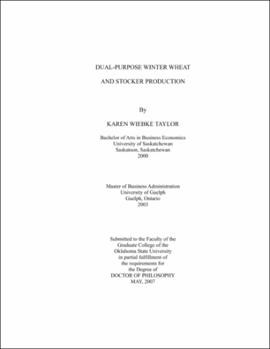| dc.contributor.advisor | Epplin, Francis M. | |
| dc.contributor.author | Taylor, Karen Wiebke | |
| dc.date.accessioned | 2013-11-26T08:22:06Z | |
| dc.date.available | 2013-11-26T08:22:06Z | |
| dc.date.issued | 2007-05 | |
| dc.identifier.uri | https://hdl.handle.net/11244/6543 | |
| dc.description.abstract | Scope and Method of Study: The purpose of this study was to research the dual-purpose winter wheat and stocker industry in the Southern Plains. Three research studies were conducted. The first study was performed to determine the value of two monensin supplementation strategies for cattle pastured on fall-winter wheat relative to the value of a free-choice mineral supplement containing no monensin. A second objective was to determine the value of extending the fall-winter wheat pasture grazing season by either one or two weeks. An enterprise budgeting framework was used to simulate returns values and then stochastic efficient with respect to a function (SERF) was performed to find risk efficient production strategies. The second study determined the optimal grazing termination date for dual-purpose winter wheat that maximizes the returns of cattle and wheat production. A second objective was to determine the value of information regarding the occurrence of first hollow stem (FHS). A profit maximization model was used. Price response functions to determine stocker sale prices and a unique plateau function to find wheat yields were found. Econometric analysis was performed to determine the optimal grazing termination date. The third study constructed a dual-purpose winter wheat and stocker production planner. The stocker planner is intended to aid stocker producers determine the optimal purchase stocker weight and gender, the optimal time to terminate fall-winter grazing on wheat intended for grain harvest, and the optimal time to concentrate animals on the proportion of wheat acres to be grazed-out. | |
| dc.description.abstract | Findings and Conclusions: The first study found that returns are greater when stocker cattle are fed a monensin containing supplement compared to high-calcium mineral. The value of grazing one or two additional weeks increased stocker returns at a decreasing rate and was less for steers than heifers. The second study found that the optimal time to terminate grazing is at or before first hollow stem (FHS). However, the costs per acre of grazing past FHS may be minimal depending on cattle and wheat prices, forage availability, cattle gains, wheat yields, and the weight of cattle. The third study is an online decision aid. | |
| dc.format | application/pdf | |
| dc.language | en_US | |
| dc.rights | Copyright is held by the author who has granted the Oklahoma State University Library the non-exclusive right to share this material in its institutional repository. Contact Digital Library Services at lib-dls@okstate.edu or 405-744-9161 for the permission policy on the use, reproduction or distribution of this material. | |
| dc.title | Dual-purpose winter wheat and stocker production | |
| dc.contributor.committeeMember | Brorsen, B. Wade | |
| dc.contributor.committeeMember | Horn, Gerald W. | |
| dc.contributor.committeeMember | Peel, Derrell S. | |
| osu.filename | Taylor_okstate_0664D_2288.pdf | |
| osu.accesstype | Open Access | |
| dc.type.genre | Dissertation | |
| dc.type.material | Text | |
| thesis.degree.discipline | Agricultural Economics | |
| thesis.degree.grantor | Oklahoma State University | |
